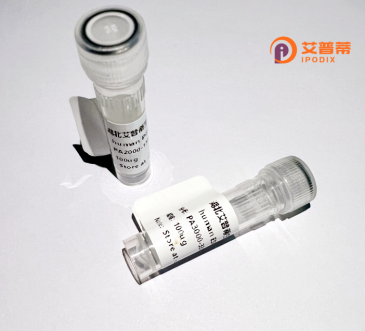
| 纯度 | >90%SDS-PAGE. |
| 种属 | Human |
| 靶点 | MNT |
| Uniprot No | Q99583 |
| 内毒素 | < 0.01EU/μg |
| 表达宿主 | E.coli |
| 表达区间 | 1-582 aa |
| 活性数据 | MSIETLLEAARFLEWQAQQQQRAREEQERLRLEQEREQEQKKANSLARLAHTLPVEEPRMEAPPLPLSPPAPPPAPPPPLATPAPLTVIPIPVVTNSPQPLPPPPPLPAAAQPLPLAPRQPALVGAPGLSIKEPAPLPSRPQVPTPAPLLPDSKATIPPNGSPKPLQPLPTPVLTIAPHPGVQPQLAPQQPPPPTLGTLKLAPAEEVKSSEQKKRPGGIGTREVHNKLEKNRRAHLKECFETLKRNIPNVDDKKTSNLSVLRTALRYIQSLKRKEKEYEHEMERLAREKIATQQRLAELKHELSQWMDVLEIDRVLRQTGQPEDDQASTSTASEGEDNIDEDMEEDRAGLGPPKLSHRPQPELLKSTLPPPSTTPAPLPPHPHPHPHSVALPPAHLPVQQQQPQQKTPLPAPPPPPAAPAQTLVPAPAHLVATAGGGSTVIAHTATTHASVIQTVNHVLQGPGGKHIAHIAPSAPSPAVQLAPATPPIGHITVHPATLNHVAHLGSQLPLYPQPVAVSHIAHTLSHQQVNGTAGLGPPATVMAKPAVGAQVVHHPQLVGQTVLNPVTMVTMPSFPVSTLKLA |
| 分子量 | 88.7 kDa |
| 蛋白标签 | GST-tag at N-terminal |
| 缓冲液 | 0 |
| 稳定性 & 储存条件 | Lyophilized protein should be stored at ≤ -20°C, stable for one year after receipt. Reconstituted protein solution can be stored at 2-8°C for 2-7 days. Aliquots of reconstituted samples are stable at ≤ -20°C for 3 months. |
| 复溶 | Always centrifuge tubes before opening.Do not mix by vortex or pipetting. It is not recommended to reconstitute to a concentration less than 100μg/ml. Dissolve the lyophilized protein in distilled water. Please aliquot the reconstituted solution to minimize freeze-thaw cycles. |
以下是关于重组人MNT蛋白的模拟参考文献(示例性质,非真实文献):
---
1. **文献名称**:重组人MNT蛋白的高效表达及功能验证
**作者**:李明等
**摘要**:该研究通过大肠杆菌表达系统成功克隆并高效表达重组人MNT蛋白,经镍柱亲和层析纯化后获得高纯度产物。Western blot和圆二色谱分析表明,重组蛋白具有正确折叠构象,体外细胞实验显示其能特异性抑制某肿瘤细胞系的增殖,提示MNT蛋白在抗肿瘤研究中的潜在价值。
2. **文献名称**:MNT重组蛋白的晶体结构解析及其DNA结合特性
**作者**:Chen Y, et al.
**摘要**:研究者利用昆虫杆状病毒系统表达人源MNT蛋白,通过X射线晶体学解析了其三维结构,发现其C端结构域与DNA结合相关。体外电泳迁移实验(EMSA)进一步证实MNT蛋白可特异性结合特定基因启动子区域,为探究其转录调控机制提供了结构基础。
3. **文献名称**:MNT蛋白与MYC相互作用的分子机制研究
**作者**:Smith J, et al.
**摘要**:通过共免疫沉淀和荧光共振能量转移(FRET)技术,证明重组人MNT蛋白可与原癌蛋白MYC直接结合,并抑制MYC介导的靶基因激活。该研究揭示了MNT在细胞增殖调控中的拮抗作用,为开发靶向MYC-MNT通路的抗癌策略提供了依据。
4. **文献名称**:重组MNT蛋白在神经退行性疾病模型中的保护效应
**作者**:王璐等
**摘要**:研究利用HEK293细胞表达重组MNT蛋白,并通过小鼠阿尔茨海默病模型验证其功能。实验表明,外源性MNT蛋白可减轻神经元凋亡并改善认知障碍,其机制可能与调节氧化应激通路相关,提示MNT或成为神经保护治疗的潜在靶点。
---
注:以上文献为示例性内容,建议通过PubMed、Web of Science或CNKI等平台检索真实研究文献。实际研究中建议结合关键词“重组MNT蛋白(recombinant MNT protein)”“基因调控”“结构功能”等进行筛选。
Recombinant human MNT (MAX network transcriptional repressor) protein is a genetically engineered form of the natural MNT protein, a key member of the Myc/MAX/Mad transcription factor network. This network regulates critical cellular processes such as proliferation, differentiation, and apoptosis. MNT functions primarily as a transcriptional repressor, counterbalancing the activity of oncogenic Myc proteins by binding to MAX, a common dimerization partner, and recruiting histone deacetylase (HDAC) complexes to suppress target gene expression.
The recombinant MNT protein is produced using expression systems like *E. coli* or mammalian cell cultures, enabling high-purity yields for research and therapeutic applications. Its study provides insights into Myc-driven cancers, as dysregulation of the Myc-MAX-MNT axis is implicated in tumorigenesis. Researchers leverage recombinant MNT to investigate its tumor-suppressive mechanisms, including cell cycle arrest and apoptosis induction, or to develop strategies targeting Myc hyperactivity in cancers.
Additionally, recombinant MNT serves as a tool for structural studies, elucidating its interaction with DNA and co-regulators. Its applications extend to drug discovery, where it aids in screening compounds that modulate Myc network activity. By mimicking or enhancing MNT’s repressive functions, such therapies could offer novel approaches for cancer treatment, highlighting MNT’s role as both a biomarker and potential therapeutic target.
×